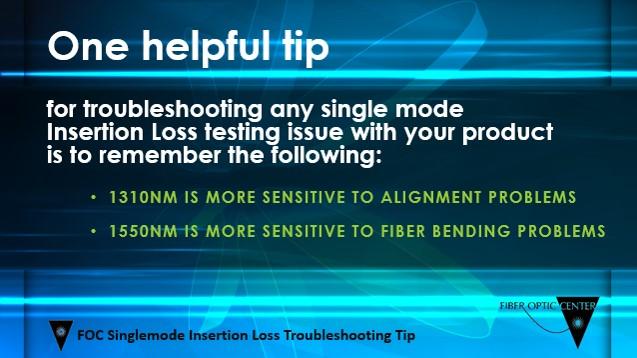In standard Singlemode cable assembly, the two wavelengths used for Insertion Loss testing are 1310nm and 1550nm. All Singlemode fibers work very similarly in either wavelength—that is, you don’t need to buy fiber based on wavelength, one fiber fits all. So, IF your cable assembly is built properly, with good materials and good techniques, the Insertion Loss values for any given connector should be very similar when tested at either 1310 or 1550.
This leads some producers to test their products with just one wavelength, testing both wavelengths only if the customer specifically requires it. Testing in both wavelengths requires additional equipment and can seem to some as nothing more than a “necessary evil”. But there are benefits to making it standard practice to test ALL fiberoptic cable assemblies at both 1310 and 1550: the Insertion Loss variation between 1310nm and 1550nm test wavelengths can be very helpful in identifying serious problems with the product and / or process.
One helpful tip for troubleshooting any Single mode Insertion Loss testing issue with your product is to remember the following:
- 1310nm is more sensitive to alignment problems
- 1550nm is more sensitive to fiber bending problems

IL @ 1310 and 1550 similar
If made properly, the cable assembly will test about the same at either 1310 or 1550. 1550 Insertion Loss results are generally better by a few hundredths of a dB, due to, in part, its lower fiber attenuation. It’s normal that Insertion Loss values for a connector be ~0.01 - 0.05 dB better at 1550 than 1310.
IL @ 1310 higher than 1550
A connector, or an entire product design, showing a significantly higher Insertion Loss at 1310 than at 1550 indicates a likely problem in core-to-core alignment between the two mated ferrules. The difference may be small, and indeed may be acceptable. The larger the misalignment, the more Insertion Loss @ 1310 compared to 1550. The cause of the misalignment could be due to many factors, most often either contamination on the product and testing components, or poor fiber core-to-ferrule concentricity.
Contamination can hopefully be removed, and the preceding manufacturing process refined to eliminate prior to testing. Poor concentricity, however, is often the result of using oversized ferrules, and thus the Insertion Loss cannot be improved without replacing the connector. “Oversized” is relative: the larger the ferrule hole bore is than the fiber OD, the most the fiber will be able to sit off to the side of ferrule center, and thus the larger the expected Insertion Loss @ 1310.
IL @ 1550 higher than 1310
A connector, or an entire product design, showing a significantly higher Insertion Loss at 1550 than at 1310 indicates the likely presence of a stress point on the fiber somewhere in the cable assembly—most likely a fiber bend that exceeds operating bend radius, or a fiber “pinch” or microbend somewhere within the product. The higher the stress (larger the bend), the higher the Insertion Loss @ 1550 compared to 1310. But whereas a core-offset problem mentioned above are often normal results of raw-material selection, any excess stress directly on a fiber represents a serious risk to product reliability, and thus IL values @ 1550 are particularly important to monitor and troubleshoot.
Even with advent of “reduced bend radius” fiber, it is excellent practice to test all products at 1550. Doing so may identify a serious product flaw, particularly in products which have fiber routed within an enclosure (such as within a cassette or a cabinet or a ribbon fan-out transition). If your product Insertion Loss @ 1550 is significantly higher than @1310, you very likely have a product with fiber under stress, and you need to understand the cause.
Additional resources from the FOC team include:
- View Test Technical Solution Content
- View the Glossary, Acronyms, Military Specifications for Connectors
- Q&A Resource: email technical questions to AskFOC@focenter.com



